October 2020 Vol. 75 No. 10
Features
Vacuum Excavator Market Surges with Enhanced Capabilities
Jeff Griffin | Senior Editor
Dual-purpose vacuum excavators are a familiar sight on underground construction job sites – especially those where there is horizontal directional drilling (HDD).
“Soft” excavation technology, employing either high-pressure water or air, allows vacuum excavators to make small, precisely controlled potholes to visibly expose existing utilities and clean up excess drilling fluids escaping from bore holes. Of course, excavation and cleanup capabilities are not limited to these tasks.
Vacuum excavators began appearing on directional drilling sites in the mid ’90s, but they have a history of being used for utility work. It dates back to the late 1950s, when a contracting company developed its own machines for “keyholing” – making small openings in the ground to make repairs to natural gas pipelines.
Utility contractors quickly saw their value for cleaning up drilling fluids from HDD sites and recognized that soft excavation was a faster and safer way to pothole.
Air or water excavation?
As demand grew for vacuum excavation, air or water was a question buyers had to address.
Those who preferred hydro excavation (which has turned out to be the most common) pointed out this method could dig in most soils, while air was limited in some conditions. Air, they said, also raised dust on job sites. Excavation with high-pressure water, they added, would not damage facilities when properly used.
Advocates for air were quick to mention that water excavation could cut through plastic pipe and insulated cable when too much pressure was applied. They also contended air equipment did not require a supply of water that had to be frequently replenished in order to continue excavating, and air would not damage existing utilities.
The issue became less pressing as equipment evolved, with many air units today also having hydro capabilities, and hydro models having air backup. Still, most owners of multiple vacuum excavators are strongly committed to one technology or the other.
For this article, four vacuum excavator manufacturers share their thoughts on the equipment and industry.
Vermeer
Manufacturing a broad line of underground construction equipment, Vermeer offers 23 vacuum excavator models ranging from small trailer and skid-mounted vacs, to large truck vacs. Many skid models can be configured with a variety of spoil tanks.
In 2018, McLaughlin and VacTron brand vacuum excavators came under the Vermeer umbrella and earlier this year, VXP was announced as a strategic partner.
“Most of the vacuum excavator market is dominated by hydro excavators, but air is used in certain geographical areas. Vermeer offers both water and air models in its product line,” said Adam Bates, Vermeer product manager. “They offer a wide range of configurations for the vacuum excavator truck market, including the new Vermeer XR2 that gives operators the ability to separate liquids and solids onsite.”
Bates said the smallest model in the Vermeer line is the McLaughlin Series ECO 25-100G with a 3-inch hose, 575 cubic feet per minute of suction and a spoil tank capacity of 100 gallons. The largest in the line is the VXT600D with a 10-inch hose, 6,400 cubic feet per minute of suction and 20- to 30-cubic-yard spoil tank.
“For utility construction, vacuum excavators are used to pothole/daylight existing utilities before new product is installed underground, as well as to haul off used drilling slurry when horizontal directional drilling is being employed.”
Vacuum excavators are thriving in several markets.
“Horizontal directional drilling for utilities is the most extensive market for smaller trailer vacuum excavators,” he continued, “while municipalities and the pipeline industry require larger truck vacuum excavator models.”
Many municipalities, he explained, use vacuum excavators to help maintain their sewer systems to access water valves and jetting lines. They also use them for soft digging when repairs are being made to existing utilities, or they are planting trees and installing poles and signs.
“Industrial plants use vacuum excavators for cleaning,” added Bates “and vacuum excavators are used in the community for installing fencing and cleaning up grain bins and animal stalls."
“Landscaping and construction contractors also use vacuum excavators from time to time to help remove old landscaping material, like mulch and small rocks, as well as for excavating in areas with buried utilities.”
The most significant technology Vermeer has introduced in the past five years is on its XR2 vacuum excavator.
“With conventional vacs,” Bates said, “liquids and solids are collected in the spoil tank, then transported to a dump site for disposal. When potholing, crews can only dig a few holes before having to head to the disposal site.
“The XR2 has a shaker deck that separates solid and liquids as material is being suctioned through the hose. Separated solids can then be stacked onsite or into a truck/trailer for transporting, and the dirty water is stored in one of the XR2 storage tanks. This technology allows contractors to carry more water (1,500 gallons) to the job and leave with approximately the same weight.”
Bates notes the demand for vacuum excavators has grown substantially over the past four years, as contractors experience the efficiency benefits compared to other digging and trenching methods.
“We expect to see continued growth for vacuum excavators,” he concluded, “as more states and communities adopt regulations that declare this type of digging can be done around buried utilities, as well more industries continue to discover all the ways they can do their jobs more efficiently with vacuum excavators.”
Ring-O-Matic
Ring-O-Matic manufactures 11 trailer-mount and 11 skid-mount vacuum excavators, and a line of vac-only machines. which includes eight trailer-mount, five skid-mount and three trailer-mounted pit cleaners. Water is the standard excavation source on all vacuum excavators, with air options on eight units.
“Advances in equipment include ease of operation, which applies to many features,” said Tony Bokhoven, director of sales and business development at Ring-O-Matic. “Also important are advancements in air digging, air filtration and noise reduction.”
Bokhoven believes what sets Ring-O-Matic equipment apart are digging capabilities of the Viper pothole tool, and the ability to operate with higher psi, air filtration and towing ease.
“Most manufacturers define vacuum excavation equipment size by spoil capacity and from there, cfm and inches of mercury, which are optioned in different combinations,” Bokhoven noted. “For our line of vac exs, our smallest is a 150-gallon unit, up to a 3,000-gallon truck-mount model. Our most popular models are the 550vx and 850vx.”
He believes the popularity of vacuum excavators is being driven by continuing utility expansion and infrastructure projects.
“That means there is more need for locate verifications with soft excavation,” he said. “Also, there is an expansion of regulations that forbid hard excavation potholing with hand digging, backhoes and other equipment. In addition, the need for mud management is increasing.
“Even though vacs have been around for a while, there still is a need to ‘sell’ the value about how vacs can save money, even though the process isn’t always a billable service.”
Super Products
Super Products offers two powerful Mud Dog truck-mounted vacuum excavator models that use water or air. The product line has multiple customers include utility contractors, industrial contractors, and oil and gas and pipeline contractors.
“They [vacuum excavators] are used for locating utilities, precision digging and environmental controlled digging,” said Michael Reis, sales manager for Super Products. “Vacuum excavators eliminate the destruction of infrastructure and property.”
As equipment has evolved, Super Products has enhanced Mud Dog’s usability, lowered the cost of the trucks and continuously improved their safety features.
“Our system is very simple to operate,” Reis stressed.
Basic specifications include:
Mud Dog 1200
- Truck-mounted, single-engine design
- 5800-cfm, 28-inch PD pump
- 1,500-gallon water capacity
- 18-gpm, 3,000-psi water pump
- 185-cfm, 175-psi air option
Mud Dog 1600
Same specs, but adds 2,000-gallon water capacity
Vacmasters
Vacmasters took a different approach, to be the leading manufacturer of equipment excavating with high-pressure air. Current models also have a water excavation option.
“Vacmasters’ air vacuum excavators are designed with automatic purge filtration, and our proprietary digging nozzles make a Vacmasters the best performing unit in the market,” said Charles Bell, sales manager. “Vacmasters are trusted air vacuum excavators and have been since the company’s conception more than
25 years ago.”
Bell said customers include HDD contractors, subsurface utility engineering firms and electrical contractors.
“Basically, anyone who needs to safely locate buried utilities,” he added.
The current product line includes:
- System 1000 – 860 cfm
- System 3000–1,220 cfm
- System 4000–1,220 cfm
- System 5000–1,700 cfm
- System 6000–2,200 cfm
- SpoilVac hydrovac excavator 520, 860, or 1220 cfm
Ditch Witch
Among the comprehensive line of underground construction equipment it manufactures, Ditch Witch markets eight vacuum excavator models.
“We offer truck-mounted vacuum excavators that can excavate with both air and water, and trailer-mounted vacuum excavators that utilize high-pressure water,” said Chapman Hancock, vacuum excavation product manager.
The equipment is available in a variety of configurations that range in tank size, cubic feet per minute and water flow.
“The most popular model is the HX30 with a 24-horsepower diesel engine providing 500 cubic feet per minute at
15 inches Hg, which can be configured with a 500- or 800-gallon debris tank,” he added.
Ditch Witch’s primary customers for vacuum excavation equipment are underground construction contractors, but “there are many other markets,” Hancock said, “including landscape and irrigation to clean flower beds, plant trees, and for the installation and maintenance of irrigation systems.”
However, the primary uses are potholing to expose underground utilities before horizontal directional drilling and ensure a safe bore path, exposing utilities for infrastructure mapping, and disposing of drilling mud and cleaning up job sites.
Advances in the last five years have focused on making the units more efficient.
“Blowers have become more efficient by requiring less horsepower, resulting in better fuel economy,” he said. “Hydro excavating nozzles have seen technological advances to provide enough pressure and water flow to excavate efficiently, while maintaining the ability to excavate safely.
“It has become a best practice in the industry to utilize a rotating or oscillating nozzle. This allows for the proper flow
and pressure, while not concentrating water flow to one area.”
Over the last several years Ditch Witch released the HX Series that now comprises a complete line of trailered vacuum excavators. Compared to previous equipment, each of the five HX models has higher ground clearance, lower overhead height and less trailer width, Hancock reported.
Trailer-mounted vacuum excavators utilize water, with systems ranging from 2.6 to 5.5 gallons per minute at 3,000 psi. These units also range from 500 cfm at 15 inches Hg, to 1,300 cfm at 16 inches Hg. Debris tank sizes vary from 150 to 1,200 gallons, and fresh-water tanks from 80 to 500 gallons.
Every Ditch Witch truck-mounted vacuum excavator can be configured to utilize both water and air. Depending on the model, debris tanks range from 500 to 1,200 gallons and fresh water from 200 to 400 gallons. Cubic feet per minute on these units is 1,000 to 1,200 at 16 in Hg.
The water systems vary from 5.1 to 5.5 gallons per minute at 3,000 psi, and the air systems from 200 cubic feet
per minute at 200 psi, to 300 cubic feet per minute at 250 psi. •
FOR MORE INFORMATION:
Vermeer Corp., (888) 837-6337, vermeer.com
Ring-O-Matic Manufacturing Co., (641) 628-1515, ring-o-matic.com
Super Products, (800) 837-9711, superproductscorp.com
Vacmasters, (800) 466-7825, www.vacmasters.com
Ditch Witch, (800) 654-6481, ditchwitch.com



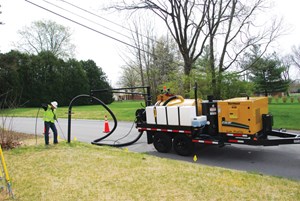
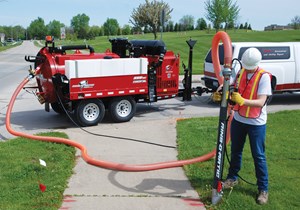
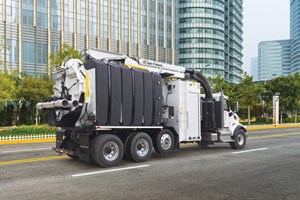
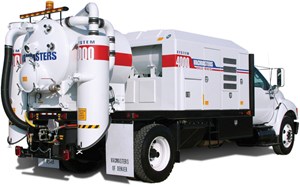
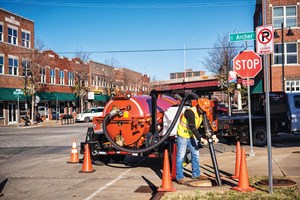

Comments